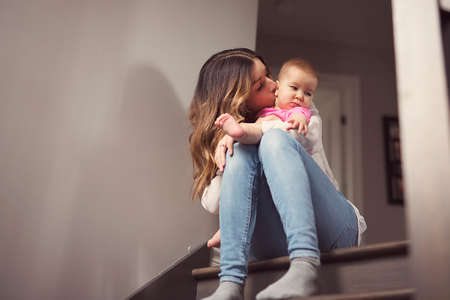Understanding Fall Risks in American Homes
When it comes to raising little ones in the United States, the layout and features of a typical American home can present some unexpected fall hazards. Unlike homes in many other countries, American houses often include multiple stories with staircases, large windows—sometimes with low sills—and balconies or decks designed for outdoor living. While these elements add comfort and style, they also create unique risks for curious babies and toddlers who are eager to explore their environment. Cultural habits, such as leaving windows open for fresh air or using upper-level balconies for gatherings, can further increase the chances of accidental falls. Understanding these specific risks is the first step toward creating a safer home environment that supports your child’s growth while keeping them protected from preventable injuries.
2. Babyproofing Stairs: Tips and Product Picks
Stairs are one of the most common places where little explorers can have accidents. Creating a safe environment starts with understanding the potential risks and taking proactive steps to minimize them. Let’s level up your babyproofing game by focusing on three key areas: child safety gates, slip-resistant materials, and smart habits.
Child Safety Gates: Your First Line of Defense
Choosing the right gate can make all the difference. Not all gates are created equal—some are designed for pressure mounting (best for doorways), while others require hardware mounting (ideal for the top of stairs). Here’s a quick comparison:
| Type | Where to Use | Pros | Cons |
|---|---|---|---|
| Pressure-Mounted Gate | Bottom of stairs, between rooms | No drilling required, easy to move | Less secure at the top of stairs |
| Hardware-Mounted Gate | Top of stairs | Very secure, recommended for high-risk areas | Permanently installed, may leave marks |
Pro Tip:
Always install gates according to manufacturer instructions and double-check latches regularly.
Slip-Resistant Materials: Boosting Traction & Confidence
Kiddos learning to walk need extra grip on those slippery steps! Consider adding non-slip stair treads or adhesive strips. Carpeting your stairs is another great option—soft landings mean fewer tears if someone takes a tumble. Here’s a quick look at popular materials:
| Material | Main Benefit | Easy to Install? | Maintenance Level |
|---|---|---|---|
| Non-Slip Treads/Strips | Adds traction instantly | Yes, peel & stick! | Low—just wipe clean |
| Carpet Runners | Cushions falls, quiets noise | Moderate—requires securing in place | Medium—regular vacuuming needed |
| Sisal or Jute Mats | Naturally slip-resistant & eco-friendly | Easy (for flat surfaces) | Low to Medium—shake out dirt regularly |
Cultivating Safe Habits: The Daily Power-Ups!
- Tidy Up Toys: Make it a fun family rule to keep stairways clear of toys, shoes, and laundry.
- Light It Up: Install nightlights near stairs so sleepy parents (and curious kiddos) can see every step.
- Model Good Behavior: Always hold the handrail and encourage your child to do the same—it’s a habit that lasts a lifetime!
- No Climbing Allowed: Teach your little one that railings aren’t for climbing or hanging on.
Your Next Move:
A little prevention goes a long way! By combining safety products with consistent habits, you’ll transform your staircase into a zone where curiosity is encouraged—and accidents are kept at bay.

3. Securing Windows: Simple Upgrades for Safety
Windows are a favorite spot for curious little explorers—kids love peeking outside and feeling the breeze! But open or unsecured windows can pose a serious fall risk in any home. The good news? There are simple, affordable ways to make your windows safer without sacrificing sunlight or style.
Easy-to-Install Window Locks
Start by adding window locks or childproof latches. These handy devices keep windows from opening wide enough for a child to slip through, but still allow you to crack them open for fresh air. Many locks are tool-free and snap right onto the window frame—a quick win for busy parents.
Window Guards: Extra Peace of Mind
For families living in multi-story homes or apartments, window guards are a smart investment. These sturdy bars fit across the lower half of the window, creating a barrier even if the window is open. Look for guards that meet ASTM safety standards and are designed with emergency release features so adults can easily remove them in case of fire.
Don’t Forget Window Screens
While screens help keep bugs out, they’re not strong enough to stop a fall. Consider reinforced safety screens if you want extra protection, but always combine them with locks or guards for best results.
Let the Sunshine In—Safely!
The goal is to create a bright, inviting space where your child can safely enjoy natural light and views. With these easy upgrades, you can relax knowing your little adventurer is protected as they grow, learn, and explore their world—one sunny day at a time.
4. Balcony and Deck Safety Essentials
Ensuring your balcony and deck are safe for curious little explorers is a big step toward a fall-proof home. Let’s level up your family’s safety game by learning how to assess and upgrade these high-risk areas with confidence.
Railing Requirements: What’s Safe?
The first checkpoint is your railings. The Consumer Product Safety Commission (CPSC) recommends that balcony and deck railings should be at least 36 inches high, with spaces between balusters no wider than 4 inches. This prevents babies and toddlers from slipping through or getting stuck.
| Feature | Recommended Standard | Why It Matters |
|---|---|---|
| Railing Height | ≥ 36 inches | Makes it harder for kids to climb over |
| Baluster Spacing | ≤ 4 inches apart | Keeps heads and bodies from squeezing through |
| Material Sturdiness | No loose or wobbly parts | Prevents collapse or accidental falls |
Secure Gates: Blocking Access When Needed
Install childproof gates at all entry points to balconies and decks. Opt for hardware-mounted gates rather than pressure-mounted types, as they’re more secure for outdoor use and uneven surfaces. Make sure the gate latches automatically so it can’t be accidentally left open during backyard adventures.
Surface Safety: Slip-Proofing Your Space
Even if your baby can’t walk yet, crawling or scooting on slippery surfaces is risky. Choose non-slip mats or outdoor rugs designed for weather resistance. Check for splinters, loose boards, or protruding nails regularly—these are game changers when it comes to preventing scrapes and tumbles.
Quick Safety Checklist for Balconies & Decks:
- Check railing height and spacing regularly.
- Tighten any loose bolts or screws on railings and floors.
- Add slip-resistant coverings on walking surfaces.
- Install sturdy, self-closing gates at all access points.
- Remove climbable furniture (like chairs or planters) away from railings.
- Supervise children closely during outdoor playtime.
Your Next Move:
Think of balcony and deck safety upgrades as power-ups in your parenting quest! By assessing and improving these areas, you give your family more freedom to enjoy outdoor spaces—without worry. Now, take a victory lap around your upgraded deck and celebrate the peace of mind you’ve earned!
5. Helping Kids Learn Safe Habits
Teaching your toddler about safety isn’t just about setting up barriers—it’s also about building lifelong habits. Use everyday moments and playful activities to help your child understand the boundaries around stairs, windows, and balconies. For example, you can turn stair climbing into a fun game where you always hold hands and count each step together. This not only makes the experience safe but also reinforces that stairs aren’t a place to run or play alone.
Make Safety Rules Fun and Memorable
Kids learn best when they’re engaged, so use songs, rhymes, or simple games to make safety rules stick. Try coming up with a catchy phrase like “We stop at the top!” for stairs or “Windows are for looking, not for climbing!” Repeat these phrases during daily routines so they become second nature. You can even create little “safety missions” where your toddler helps you check that gates are closed or that toys are picked up off the floor near dangerous spots.
Encourage Careful Choices Through Play
Dramatic play is a powerful way for young kids to practice decision-making. Set up pretend scenarios with dolls or action figures—maybe one tries to climb over a toy balcony or peek out a window. Pause the story and ask your child what the safest choice would be. Celebrate their good decisions with high fives or stickers, turning safety learning into a confidence-boosting adventure.
Model Safe Behaviors Every Day
Your actions speak louder than words. Always model safe behavior around stairs, windows, and balconies—hold onto railings, close safety gates behind you, and never lean out of windows. When your child sees you making careful choices, they’ll be more likely to copy you. Over time, these small daily lessons add up, helping your little one develop an inner compass for safety both now and in the future.
6. Emergency Preparedness: Responding to Falls
No matter how much you babyproof your home, accidents can still happen. That’s why having a smart action plan is just as important as prevention. Here are some game-changing tips and guidance every parent should know to respond confidently if your child takes a tumble.
Stay Calm and Assess the Situation
Your first superpower is staying calm. Take a deep breath, and check your child for obvious injuries. Look for bumps, bruises, bleeding, or if they’re acting differently (like being unusually sleepy or irritable). If your child lost consciousness, has trouble breathing, or you see signs of a serious head injury, call 911 immediately.
Quick-Action Steps After a Fall
- Don’t move them right away if you suspect neck or back injury—wait for medical professionals.
- Apply gentle pressure to stop any bleeding with a clean cloth.
- Use ice packs wrapped in a towel for swelling or bumps.
Create Your Emergency Action Plan
Just like practicing fire drills, talk through what to do if there’s a fall at home. Keep emergency numbers posted on the fridge and saved in your phone. Make sure all caregivers know where your first aid kit is and how to use it. It’s also helpful to learn basic first aid and CPR—many community centers offer fun, interactive classes.
When to See a Doctor
- If your child vomits more than once after a fall
- If they seem overly drowsy or confused
- If you notice any unusual behavior or difficulty moving limbs
Remember, being prepared doesn’t mean expecting the worst—it means being ready to level up your parenting skills whenever life throws you a curveball. With these tips and an action plan in place, you can handle falls with confidence and keep your little explorer safe as they grow.

